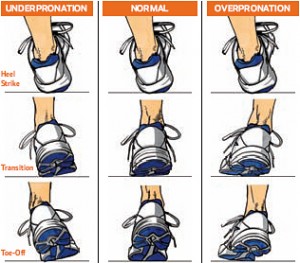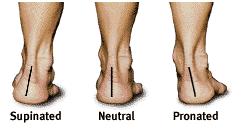In the last post we discussed how to assess your foot type in static positions. Knowing your static foot type gives you a good place to start, but you really want to be choosing your footwear based on the dynamic support it can provide for your athletic activities. However, for a true dynamic assessment you should seek the help of a trained individual.
Hopefully this post will give you some useful information to help you understand more about your possible dynamic foot type.
Assess Your Foot Type
3 Foot Types
Remember this is a CONTINUUM and an oversimplification.
- Supinators (pes cavus, high arching feet)
- Neutral
- Pronators (pes planus, flat feet)
3 Ways to Assess Your Dynamic Foot Type
- Balance on 1 Foot (Barefoot) – Try to balance for 30sec-1min to allow the possible instability to display itself. Placing a camera behind to view the heel and subsequent movement will provide the best assessment
- Check Your Kicks – Look at the soles of your old shoes (supinators wear on the outside toes, pronators wear more on the inside toes)
- Film Yourself Running on a Treadmill – Of course a 30 sec clip of a quick jog won’t provide the most accurate assessment of how your running gait, but may show some possible tendencies. A proper gait analysis involving the whole body from various positions would be required to truly assess for foot type and preferred footwear.
Results
Pronator
◊ If your foot has the tendency to “roll in” ( inner ankle goes towards the ground)
◊ Heel is angled outward (rear foot eversion, calcaneovalgus)
Chris Johnson has a great post and video of someone who dynamically pronates (“runner’s wobble”).
http://chrisjohnsonpt.com/the-wobbly-runner-and-recurrent-injury/
Neutral
◊ If your foot has minimal movement and stays in neutral position
◊ Heel is angled vertically
Supinator
◊ If your foot has the tendency to “arch up” (outer ankle goes towards the ground)
◊ Heel is angled inward (rear foot inversion, calcaneovarus)
Example of Gait Analysis at the Foot/Ankle
This picture shoes an oversimplification of what a video analysis of running gait may show at the foot and ankle.

A simplified view of what to look for from heel strike to toe-off (left foot) : supinators, neutral, pronators respectively. (Picture from http://wiki.runnersworld.com/index.php/Pronation)
Now What…
Having an idea of your static and dynamic foot type will give you a better idea of what type of shoe is best for you. Again, it’s best to get a professionals opinion, especially if you are experiencing injuries or pain. But hopefully these last 2 posts will provide some information to help you understand your foot type.
The next post will deal with the types of shoes available and how they correlate with foot type.
Part 1 – Static Assessment of Foot Type
Update 2015
While this blog post series may provide some helpful knowledge, it should be known that static foot posture and selecting shoes based off of this foot type is not the best option. For more information please read this article on pathomechanics and refer to the GaitGuys for the most up to date information on shoes, feet, and gait.



